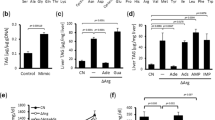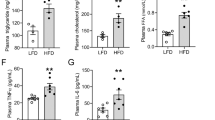Abstract
RATS fed on Himsworth's1 necrogenic diet have livers that are histologically undamaged, except for mild fatty infiltration, until an episode of acute massive necrosis occurs. Schwarz et al. 2 reported that liver slices from animals fed a necrogenic diet showed a metabolic abnormality at times when the livers were still normal hisbologically. The abnormality consists of an inability of these slices to maintain oxygen uptake for more than about 30 min. when incubated in Ringer solution at 38° with oxygen.
This is a preview of subscription content, access via your institution
Access options
Subscribe to this journal
Receive 51 print issues and online access
$199.00 per year
only $3.90 per issue
Buy this article
- Purchase on Springer Link
- Instant access to full article PDF
Prices may be subject to local taxes which are calculated during checkout
Similar content being viewed by others
References
Lindan, O., and Himsworth, H. P., Brit. J. Exp. Path., 31, 651 (1950).
Chernick, S. S., Moe, J. G., Rodnan, G. P., and Schwarz, K., J. Biol. Chem., 217, 829 (1955).
Cohen, P. P., in “Manometric Techniques and Tissue Metabolism”, ed. Umbreit, 119 (Burgess, Minneapolis, 1949).
Gallagher, C. H., Gupta, D. N., Judah, J. D., and Rees, K. R., J. Path. Bact., 72, 193 (1956).
Author information
Authors and Affiliations
Rights and permissions
About this article
Cite this article
McLEAN, A. ‘Phenergan’ and Versene in Dietary Liver Necrosis. Nature 185, 191–192 (1960). https://doi.org/10.1038/185191a0
Issue Date:
DOI: https://doi.org/10.1038/185191a0
This article is cited by
-
Der Einflu\ verschiedenartiger Substanzen auf die akute Tetrachlorkohlenstoff-Nekrose der Rattenleber
F�hner-Weilands Sammlung von Vergiftungsf�llen Archiv f�r Toxikologie (1965)
-
Protection by Antioxidants against Lethal Doses of Carbon Tetrachloride
Nature (1961)
-
Protection against Liver Injury due to Murine Hepatitis Virus
Nature (1960)
-
Phosphoproteins and Mitochondrial and Cell Water
Nature (1960)
-
Intracellular Potassium in Dietary Liver Necrosis
Nature (1960)
Comments
By submitting a comment you agree to abide by our Terms and Community Guidelines. If you find something abusive or that does not comply with our terms or guidelines please flag it as inappropriate.



